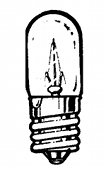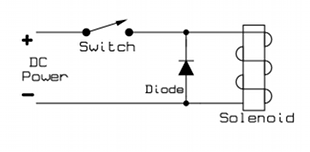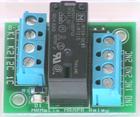|
|
|
|
|
Relay Contact Ratings
Let your relays live a long and happy life.
|
The contacts of mechanical switches and relays are movable pieces of metal that are designed to open and close an electrical circuit. When the contacts are closed, an electric current flows through the contacts, and when the contacts are opened, the current stops.
Switch and relay contacts all have a current rating. This rating is specified by the manufacturer, and it tells you how much current the contacts can safely turn on and off. If you use a switch or relay to control more than its rated current, it will likely go to an early grave.
Relays that switch more than their rated current often end up with their contacts welded together. They appear to be 'on' all the time.
Note that contact ratings are for resistive loads. You must take extra precautions if your relay is switching a circuit with incandescent lamps or inductive loads such as solenoids or another relay coil.
-
Incandescent lamps have very low resistance when they are off and the metal filament is at room temperature. Check this yourself with an ohm meter.
 When an incandescent lamp is first switched on, its initial low resistance allows a large amount of current to flow through it and through the switch or relay contacts. This brief inrush current is roughly 8 times the lamp's rated current.
When an incandescent lamp is first switched on, its initial low resistance allows a large amount of current to flow through it and through the switch or relay contacts. This brief inrush current is roughly 8 times the lamp's rated current.
To help your relays and switches live a long happy life, have them switch incandescent lamps that normally consume 1/8th of the contact current rating or less. That's right, 12.5% or less. For example, if a relay is rated for 0.5 amps, only switch an incandescent lamp rated at 62 mA (0.062 Amps) or less.
Alternatively, a resistor in series with the lamp can limit inrush current to a safe level. Choose a resistance that will limit current to a safe level when the lamp filament is essentially zero ohms. Choose the resistor wattage so it can handle the lamp's normal operating current.
LEDs are not subject to this limitation. LED current is controlled by a resistor, so you can use the relay's full current rating.
-
Inductive loads are electrical loads involving a coil of wire, such as a solenoid, electromagnet or a relay coil. Current flowing in a coil creates a magnetic field around the coil. When the load is disconnected, the magnetic field collapses. The energy from the collapsing field tries to keep the current flowing in the coil. If this current has no place to go, a very high voltage is created across the coil -- and its polarity will be opposite of the voltage that had been applied to the load.
 This high voltage will appear across the switch or relay that turned off the inductive load, and can severely shorten the life of the switch or relay contact.
This high voltage will appear across the switch or relay that turned off the inductive load, and can severely shorten the life of the switch or relay contact.
One way to protect the switch is to connect a reverse diode as shown here. When the coil is connected to a DC power source, the diode is reverse biased and does not conduct. When the switch is opened, the collapsing magnetic field creates a reverse voltage across the coil, causing the diode to conduct. Current flows through the diode and the coil until the energy from the magnetic field is dissipated.
Some relays, such as the Azatrax MRAPR Auxiliary Power Relay already have a protection diode built in. In fact, the MRAPR Relay has a built-in bridge rectifier, so it can be used with AC circuits as well as DC.

|
Azatrax MRAPR-12v DPDT relay
• 8 amp contacts
• Coil 10-17 volts, AC or DC, resistance 360 ohms
• Screw terminal connections
• On-board LED indicator
• Flyback protection diodes
|
|
Azatrax MRAPR-24v DPDT relay
• 8 amp contacts
• Coil 20-30 volts, AC or DC, resistance 1440 ohms
• Screw terminal connections
• On-board LED indicator
• Flyback protection diodes
|
|
© copyright 2009-2025 Azatrax LLC, Longmont, Colorado
|
|

 When an incandescent lamp is first switched on, its initial low resistance allows a large amount of current to flow through it and through the switch or relay contacts. This brief inrush current is roughly 8 times the lamp's rated current.
When an incandescent lamp is first switched on, its initial low resistance allows a large amount of current to flow through it and through the switch or relay contacts. This brief inrush current is roughly 8 times the lamp's rated current.
 This high voltage will appear across the switch or relay that turned off the inductive load, and can severely shorten the life of the switch or relay contact.
This high voltage will appear across the switch or relay that turned off the inductive load, and can severely shorten the life of the switch or relay contact.
